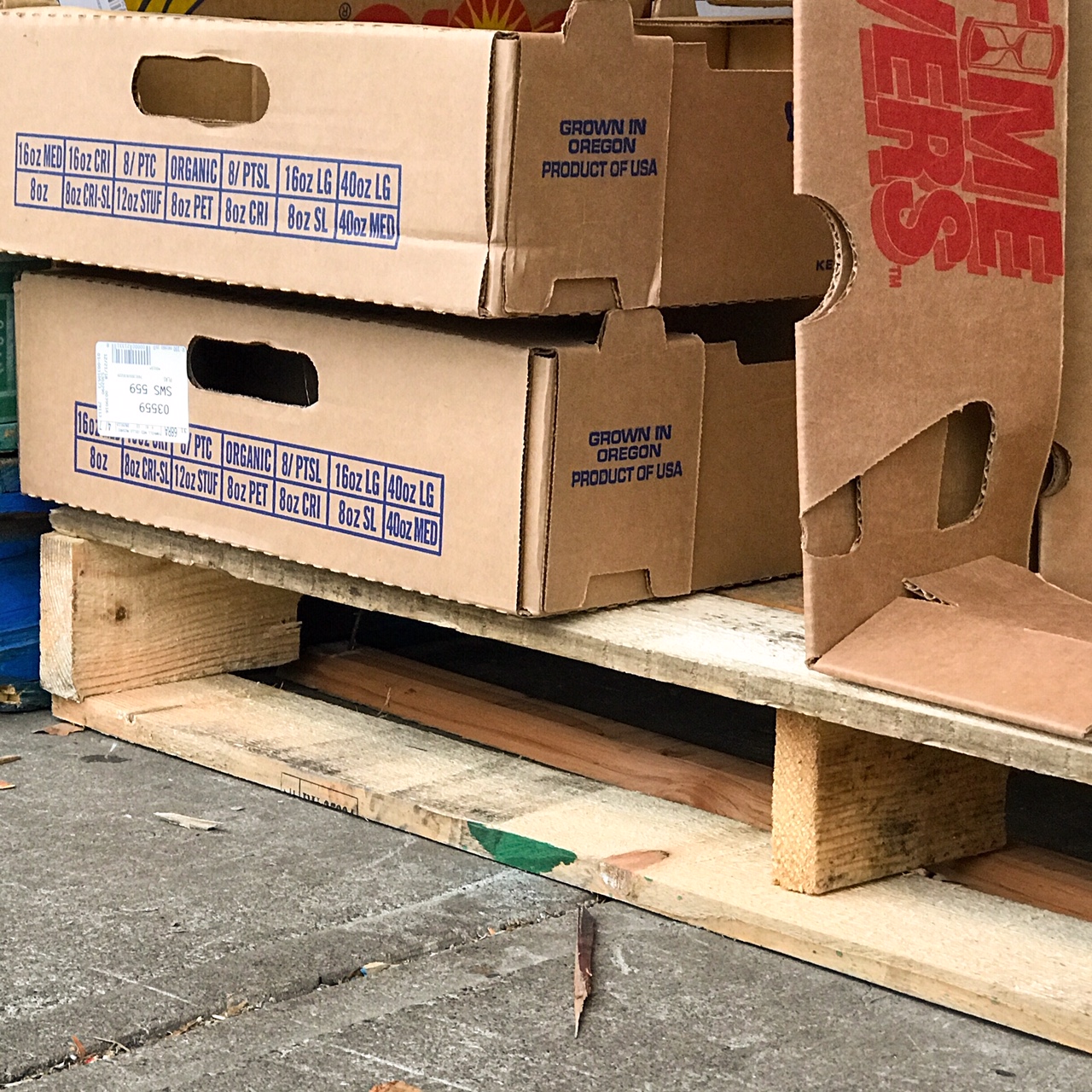The global economy goes ‘round and ‘round, mostly on humble wooden pallets that are literally the prime movers of the world’s goods.
You can see pallets anywhere that there are shipping containers, trucks, and markets. Though crude pallets existed in ancient times, it wasn’t until World War II—with its massive logistics—that pallets revolutionized shipping procedures and became widespread.
Use of pallets leads to great efficiency in loading, unloading, and handling of products and food. At any given time, there are billions of pallets in use in North America. Construction of wooden pallets is a huge industry in the U.S., but by far the majority of the pallets here are made abroad from wood harvested overseas.
Photo credit: Leialoha Perry
These billions of pallets from overseas can contain a hidden scourge: foreign wood-borne insects and pathogens. Stowaway insects or pathogens can travel from their native country, where defenses have presumably evolved, to other countries where forests might be defenseless against the newly introduced species.
Wood for pallets is generally cut from the very outer portion of logs, in segments that are not wide enough for higher-value lumber. The outer portions of logs are where many insects deposit their eggs and where their larvae mature.
A number of major infestations in the U.S.—and no doubt other countries—were started by small numbers of wood-borne pests that arrived imbedded inside of wooden pallets.
Bark beetles are the most common hitchhikers found in pallets, with longhorned beetles coming in second. Most come from Asia.
As examples of pallet-borne pests, scientists believe the emerald ash borer (a native of northern China and Korea) and the Asian longhorned beetle (also a native of China and Korea) arrived in the U.S. inside pallets constructed abroad.
The emerald ash borer, a tiny emerald-green beetle, surfaced near Detroit in the early 2000s. Since then, it has been killing ash trees of nearly every species of ash in 30 states in eastern U.S. and is gradually moving westward. The Oregon Dept. of Agriculture believes the borer’s arrival in the Pacific NW is imminent.
emerald ash borer
Photo credit: Dr. James E. Zablotny, USDA
The Asian longhorned beetle surfaced in New York City in the late 1990s. Since then, it has busily eradicated trees in 15 different families, starting again in eastern U.S. and gradually moving westward. The favorite food of these beetles is maple trees (all species). The beetles also eat birches, poplars, willows, and other hardwoods. According to the USDA, the Asian longhorned beetle has the potential to cause more damage than Dutch elm disease, chestnut blight, and gypsy moths combined.
Asian longhorned beetle
Photo credit: USDA
Because wood-boring beetles like these first arrive in port cities, the initial damage that they cause centers on cities and their residents and only later moves to forests. Think tree-lined streets and residential landscaping ... Cities and their residents have incurred billions of dollars in damages from emerald ash borers and Asian longhorned beetles.
Beginning around 2002, the United Nations, along with regulators from around the world, addressed the transport of insects and pathogens inside pallets and wood crates. The regulators developed a standard for sterilizing wood called “ISPM 15,” which stands for International Standards for Phytosanitary Measures No. 15.
By 2006, about 70 countries (including the U.S.) had signed on to ISPM 15. Today, 183 countries are signatories to the ISPM 15 standards.
The standards originally had 3 components for all wooden pallets and crates used in international trade: First, the wood had to be debarked. Then, the wood had to be sterilized by either (i) heat treatment or (ii) fumigation with methyl bromide, a chemical widely used in agriculture to control a variety of insects, fungi, and other pests.
But methyl bromide depletes the ozone layer, so its use is gradually being phased out. Since 2015, methyl bromide fumigation is not used for pallets except in limited circumstances. Other newer methods, including microwaving the wood, are now permitted or under evaluation for sterilizing pallets.
These days, about 98% of pallets in the U.S. are certified by the originating country as complying with current ISPM-15 standards. Despite these certifications, new species of insect pests arrive here inside pallets each year.
This continuing scourge may be the result of transgressions by pallet manufacturers or certifiers; or from the 2% of pallets that aren’t certified. Without 100% compliance—which may be impossible to achieve—there is no end in sight.
Try to check trees in your neighborhood every August, when wood-boring insects typically emerge from beneath the bark. Look for holes in the bark. If you see something, say something!
There are other ways that wood-boring beetles can travel long distances: If you are car-camping or RV’ing, please don’t buy firewood in other parts of the country and drive it to the Pacific NW!
Sources:
https://www.pri.org/stories/2018-12-10/insects-slipping-us-are-causing-billions-dollars-damage
https://www.nrs.fs.fed.us/disturbance/invasive_species/wood_packaging_material/
http://www.washingtonpost.com/wp-dyn/content/article/2010/12/12/AR2010121202126.html?noredirect=on
https://pnwisa.org/2017/08/state-asks-you-to-check-trees-for-invasive-pests-in-august/
https://www.ktvz.com/news/as-tree-killing-insect-threatens-oregon-has-a-plan/755190704
https://www.ippc.int/static/media/files/publication/en/2016/06/ISPM_15_2013_En_2016-06-07.pdf





